Contents
Market Overview
Macro Review
IMF meetings limit EM volatility. The IMF also published the latest set of growth expectations, taking their U.S. forecast up by 1.3ppts to 6.4% for 2021. Equal focus was placed on U.S. tax hikes and Biden’s infrastructure package, but the narrative seems well understood given inflation swaps continued to tighten. Minutes of the March FOMC offered some caution around the tapering timetable, while highlighting if any undue pressure emerged on overnight rates then the Fed would react (via hiking the IOER or RRR rates). The macro tape was generally risk-on with U.S. equities up 3-5% as the NYFANG put together eight consecutive up sessions. The VIX now trades with a 16-handle, as does the EuroStoxx V2X with Eurozone PMIs outperforming once again (adding fuel to the Citi Surprise indices). Rates steepened which was led by 5y/7y outperformance, with 5y5y inflation now 8bp tighter through April. The dollar was also almost 1% weaker this week, which is the largest episode of USD weakness over a one-week period since mid-December. This offered a renewed bid for EMFX as the GBI-EM gained 1.3%, which also reflects the largest weekly gain since mid-November.
EM Credit Update
EM Credit ended the week up 0.8% with spreads 1-5bp tighter, despite U.S. Treasuries bear steepening (long-end underperformed by 2-3bp). At the sovereign-level, Sri Lanka, Angola and Gabon outperformed, while Lithuania, Argentina and Mozambique lagged. U.S. Treasuries in the 30yr tenor may well be 3-5bp wider over the past month, but we are continuing to see EM duration outperform with modest returns of 0.6% in four weeks. Improving technicals in the asset class are conducive to a retracement rally as markets find further stability as the latest data point to healthy inflows into U.S. and EM credit.
The Week Ahead
The focus of next week is likely on U.S. inflation, along with a slew of releases out of China (trade data, retail sales and industrial production). Similarly, India’s industrial production and inflation release are key events after INR volatility last week that was sparked by a dovish RBI. Speaking of inflation, it ought to tick-up higher in Israel with further releases out of Argentina and Romania. Back in March, Ukraine was the first EM central bank to begin the hiking cycle, which was subsequently followed by Brazil, Turkey and Russia. Consensus is pointing to another 50bp hike in Ukraine’s key benchmark rate next Thursday (currently 6.5%). However, the main fixture next Thursday falls with Turkey’s CBRT but expectations are that rates remain unchanged at 19% under the new Governor (albeit with a wide tail).
This week’s emerging markets highlights discussed below include: IMF revised global growth forecasts upwards; emphasis for sustainable and inclusive recovery; Moment of truth for Turkish assets on April 15 when the Central Bank (CBRT) delivers first monetary policy decision after the abrupt firing of former Governor Agbal rattled markets in late March; Much tighter than expected second round race in Ecuador’s Presidential Elections keeps alive possibility of a credit-positive upset victory by market-friendly candidate Lasso; Indirect Iran-U.S. negotiations conducted in Vienna initial step towards potential JCPOA revival; Angola government held constructive non-deal investor roadshow and Global Emerging Markets Corporates in Focus: Considering the potential implications of the Archegos fallout.
Fixed Income
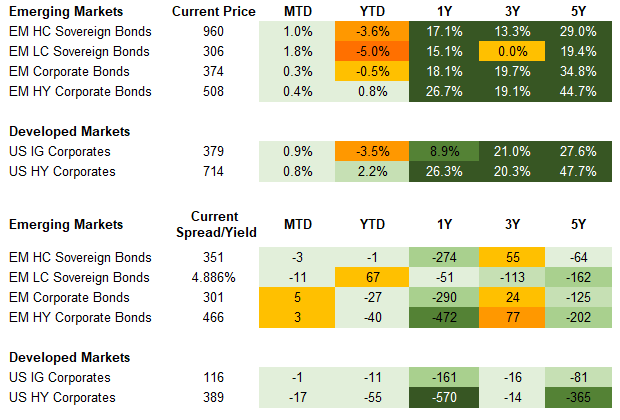
Equities
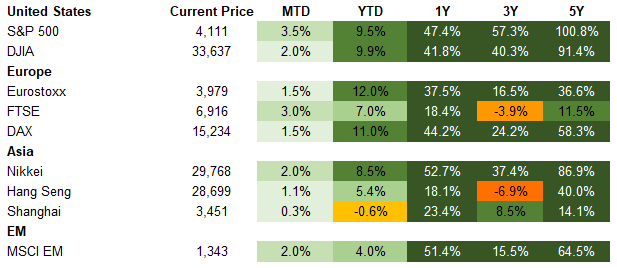
Commodities

Source for data tables: Bloomberg, JPMorgan, Gramercy. EM Fixed Income is represented by the following JPMorgan Indicies: EMBI Global, GBI-EM Global Diversified, CEMBI Broad Diversified and CEMBI Broad High Yield. DM Fixed Income is represented by the JPMorgan JULI Total Return Index and Domestic High Yield Index. Fixed Income, Equity and Commodity data is as of April 9, 2021 (Mid Afternoon).
Emerging Markets Weekly Highlights
IMF revised global growth forecasts upwards; emphasis for sustainable and inclusive recovery
Event: The IMF published its April World Economic Outlook report where it increased its 2021 global growth forecast by 50bps to 6% led by advanced economies (+80bps to 5.1%) most notably the U.S. (+130bps to 6.4%). The estimate for emerging and developing economies was lifted by 40bps to 6.7%. The overall better economic prospects stem from vaccinations, stimulus efforts mostly in the U.S., and less severe economic consequences from rolling lockdowns. The rebound remains disperse in nature with many emerging market countries and sectors far from pre-COVID GDP levels and cyclical in nature.
Gramercy Commentary: The Fund’s latest assessment aligns with our theme of economic recovery and divergence as outlined in our 2Q Strategy Outlook published last week. While growth forecasts for most countries have been revised upward in the better global economic backdrop, we continue to expect the degree of recovery to vary significantly on virus and vaccine management, economic openness particularly to the U.S., and the ability to effectively recalibrate macroeconomic policy amid evolving external growth and financial conditions. The IMF’s SDR increase and extension of DSSI through year-end should provide additional liquidity to select high-yield credits in the backdrop of upward pressure on U.S. rates. While vaccine strategy and policy remains the primary focus in the near term, countries which lay the groundwork to effectively pivot policies to improve productivity and generate sustainable, inclusive, and green growth going forward should outperform over the medium term.
Moment of truth for Turkish assets on April 15 when the Central Bank (CBRT) delivers first monetary policy decision after the abrupt firing of former Governor Agbal rattled markets in late March
Event: On this coming Thursday, the Central Bank of Turkey (CBRT) will hold its first monetary policy meeting under new Governor Kavcioglu since President Erdogan’s controversial firing of previous Governor Naci Agbal. During his short 4.5-month stint at the helm of CBRT, Agbal presided over a material tightening of monetary policy (875bps) and rebuilding of market confidence.
Gramercy commentary: As we wrote in our previous Turkey commentary, the firing via a midnight decree of former Governor Agbal just two days after CBRT’s decisive consensus-beating 200bps rate hike on March 18 re-opened a large “credibility gap” between markets and the Turkish authorities. Meanwhile, official year-on-year headline inflation (CPI) accelerated further to 16.2% in March, from 15.6% in February, while FX reserves remain at record low levels. In addition, the significant weakening of the currency following Governor Agbal’s dismissal will certainly add to inflationary pressures in the coming months and the global macro environment has taken a less benign turn for Turkey given increasing U.S. interest rates and higher oil prices. All of these factors argue that the new CBRT leadership should maintain and even further tighten the monetary policy stance, in our view. Measured against significant market concerns about CBRT’s ability and willingness to do so, the initial signals from Governor Kavcioglu and his team have been constructive and reassuring from a markets’ perspective. As such, we are of the view that a pre-mature easing of monetary policy is unlikely to occur next week. However, we cannot rule out such a disruptive scenario completely, given resumption this week of controversial/unorthodox comments on economic policy by President Erdogan. If imminent rate cuts were to materialize, it would be a major policy mistake, in our view. It would likely plunge Turkish markets back into turmoil after a tentative recovery over the last couple of weeks on an overall constructive tone by the new CBRT leadership team since taking over on March 20.
Much tighter than expected second round race in Ecuador’s Presidential Elections keeps alive possibility of a credit-positive upset victory by market-friendly candidate Lasso
Event: Ecuadorians will go to the polls on Sunday, April 11, to elect their next president in a tightening runoff race between right-wing pro-market candidate Guillermo Lasso and leftist economist Andres Arauz, supported by and seen as a proxy for former President Rafael Correa.
Gramercy commentary: The trajectories of economic policy in Ecuador’s fragile dollarized economy and cooperation with the IMF largely hinge on the outcome of Sunday’s elections. Correista candidate Arauz appears to still have an edge thanks to his 13 percentage points advantage over Lasso in the first round that is difficult to overcome. However, the race has tightened materially according to the most recent polls. In addition, our analysis of the post-first round political dynamics in the country indicates that Lasso has a fighting chance and a path to victory. Critically important for the ultimate outcome would be how supporters of indigenous candidate Yaku Perez split their second round vote across three options: Arauz, Lasso and Null. As a reminder, Perez came in third in the first round with close to 1.80 million votes vs Lasso’s 1.83 million. The other key variable will be if the 1.45 million people who voted for Havier Vergas, fourth in the first round, will listen to their leader who has formally endorsed Lasso against the return of Correismo. Economic policy by the incoming administration will determine the pace of recovery from the ongoing pandemic-related shock and Ecuador’s ability to attract foreign financing, the lifeline of its dollarized economy. The latter also depends significantly on the continuation of excellent relationships with the IMF that have come to define the time in office of the outgoing Moreno Administration. In the context of the pre-election campaigns, Correista candidate Arauz has expressed views on economic policy that could prove problematic for the existing IMF program if they were to turn into real policy objectives. Lasso’s policy priorities are likely to be much more compatible with those of the IMF. For its part, the Fund has clearly indicated that they are eager to work with the new administration, regardless of its ideological bias, and are open to adjusting program conditionality as long as it remains consistent with supporting Ecuador’s fiscal and external adjustments. Markets have thus far reacted timidly to the tightening of polls in Lasso’s favor. We attribute this to the bad historical track record of Ecuadorian polls, the large share of undecided voters that make the race highly unpredictable and Arauz’s sizable lead from the first round. Against this backdrop, in the event Lasso is able to pull an upset victory on Sunday, we expect a significant positive market reaction. In that scenario, Ecuador’s sovereign risk will likely start to reprice on better outlooks for both economic policy and IMF cooperation.
Indirect Iran-U.S. negotiations conducted in Vienna initial step towards potential JCPOA revival
Event: U.S. and Iran negotiators held meetings in Austria throughout the week to discuss sanctions and nuclear issues. As a preliminary stage, the dialogue was brokered by the Europeans and reportedly did not involve direct interaction between the U.S. and Iran.
Gramercy Commentary: The U.S. authorities have made clear that the path back to re-entry into JCPOA (Joint Comprehensive Plan of Action) and sanctions removal will be challenging and complex. Given the likely lengthy process of negotiations and Iranian presidential elections in June, it is unlikely that an agreement is reached and sanctions begin to be materially lifted until 2H21. The implications for the oil market will depend on supply and demand conditions as an agreement nears.
Angola government held constructive non-deal investor roadshow
Event: Event: On Wednesday, the authorities provided an update to investors on the country’s economic and financial position as well as its policy outlook. The IMF team also held meetings with various groups of investors throughout the week.
Gramercy Commentary: Both government and IMF meetings reiterated the authorities’ near term commitment to reform and satisfactory performance under the existing $4.5bn EFF program, of which $1.5bn remains unused. Fiscal prudence persists after solid consolidation pre-COVID and tailored support amid the pandemic. Higher oil prices combined with debt relief from DSSI and major bilateral creditors (~$6bn over 2 years) has improved FX liquidity conditions. The privatization agenda remains intact albeit delayed with any proceeds providing upside risk to IMF assumptions. Monetary aggregate targets are being met and FX rate dynamics have improved with a narrower and more consistent gap between the official and parallel rates. Negative real rates pose moderate risk as the externa backdrop evolves. Structural challenges of declining oil production and high risk of unsustainable debt pose threats to the medium term outlook particularly in the backdrop of a sustained lower oil price environment. A new IMF program following the conclusion of this program in November would likely be challenging ahead of elections in mid-2022 but there should be prospects for ongoing technical support and close relations similar to the approach adopted by the Ghanaians after the conclusion of their program in 2019.
Global Emerging Markets Corporates in Focus: Considering the potential implications of the Archegos fallout
Event: A flurry of activity in recent weeks has centered around Archegos Capital Management, a family investment office headquartered in the US. Concerns remain about the implications of those events for various market participants around the world.
Gramercy Commentary: Increased supervision of family offices has been mooted (not for the first time). Opponents state that regulators should not dictate how individuals or families choose to invest their own funds. However, regulators already do in some ways. As one example, there are restrictions on buying contingent convertibles. The opposition to increased supervision appears may relate more to UHNW individuals and families. Nonetheless, some reports have noted that there are former hedge funds which are now family offices, but which continue to make public disclosures. Having said all this, it is unclear that this is the right focus as the largest single-family offices are not known to use leverage in the ways Archegos did (though additional disclosures may prove otherwise). There may be greater scrutiny of company ownership disclosures where banks or brokers are listed as significant holders (as was the case with some Archegos investments). Such ownership may increasingly be seen as a ‘red flag’ and could affect some businesses within these banks and brokerages. In addition, prime brokerage businesses could under pressure. These operations may be the focus of regulatory scrutiny. It may be seen as easier for supervisors to impose restrictions on entities which are already closely monitored (banks and brokers) than entities which are not. The derivatives market is also likely to receive additional focus, and a more holistic view of leverage may be needed. There may be increased focus on limiting and/or monitoring banks’ off-balance sheet positions. Greater regulatory coordination, which has been hard to achieve even in the best of times, may be needed. The potential impact of one-off losses on credit instruments with discretionary payments is also worth highlighting. Additional Tier 1 securities issued by financial institutions are generally structured to absorb going concern losses, and may come under pressure in such circumstances. This debacle may be seen as an opportunity for buybacks at targeted companies. As one example, Tencent Music announced a USD1bn buyback, its biggest ever, following the initial Archegos headlines. Finally, while not much weight may be placed on rating agency actions, these changes are worth following. Downgrades to issuer ratings may trigger cuts to subordinated obligations’ ratings and commentary from rating agencies can highlight broader concerns about affected issuers and markets.
Emerging Markets Technicals
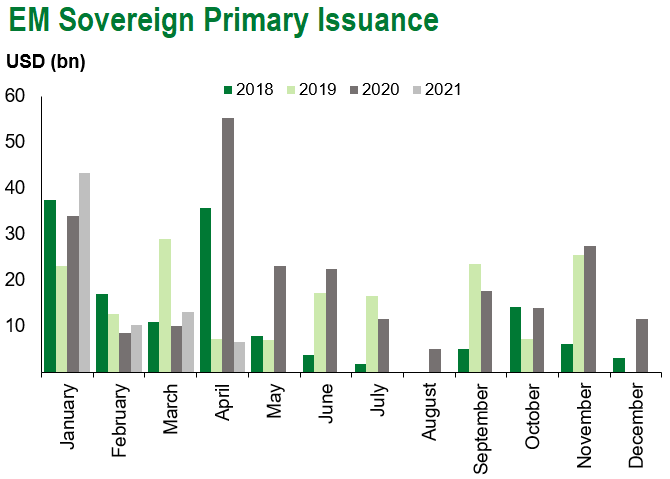
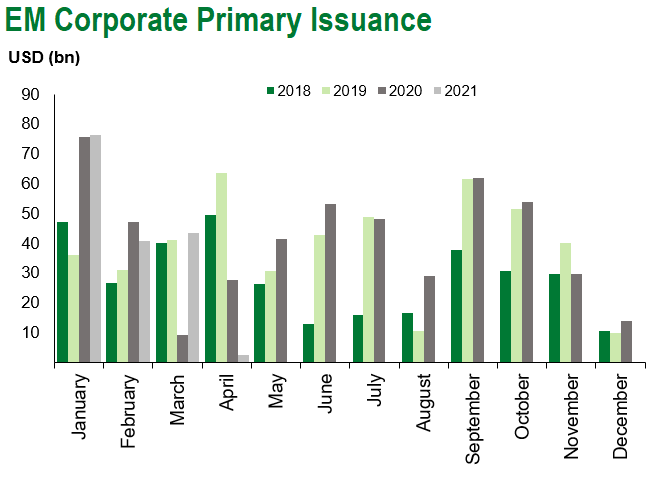
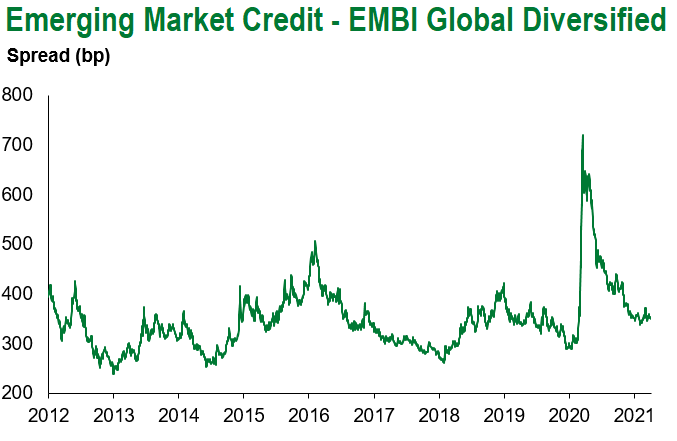
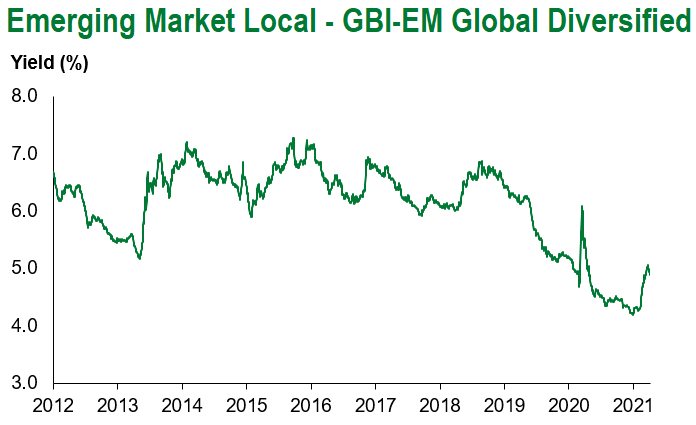
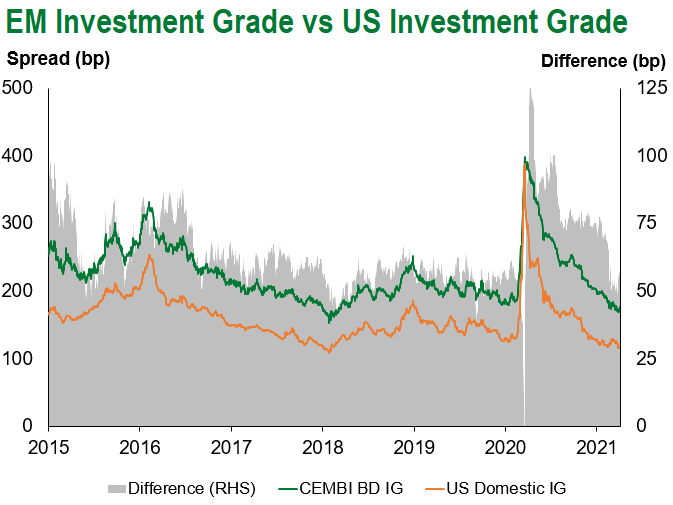
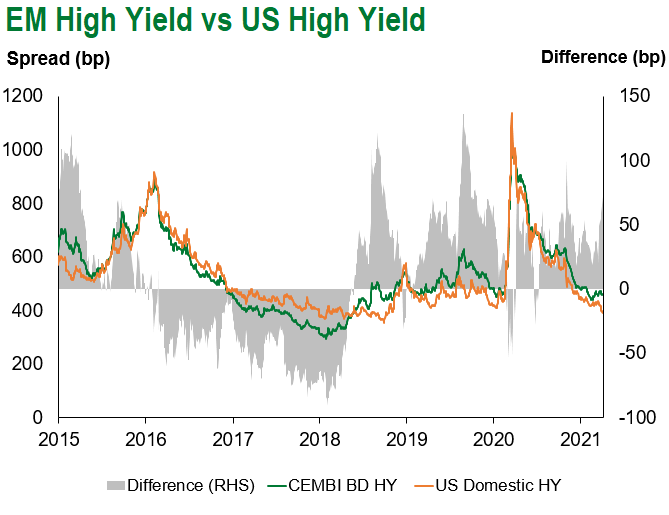
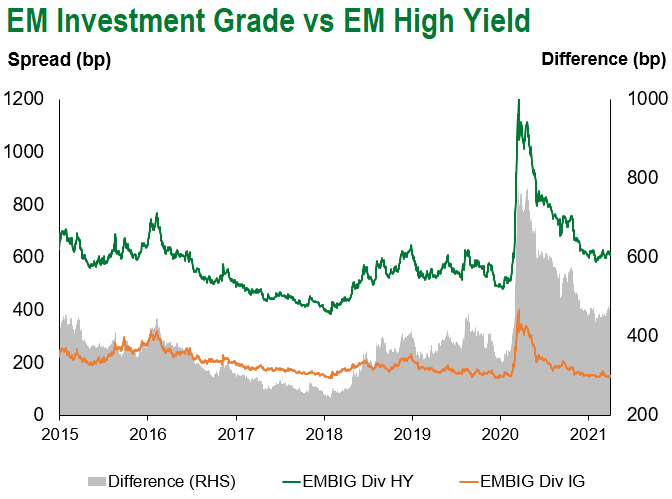
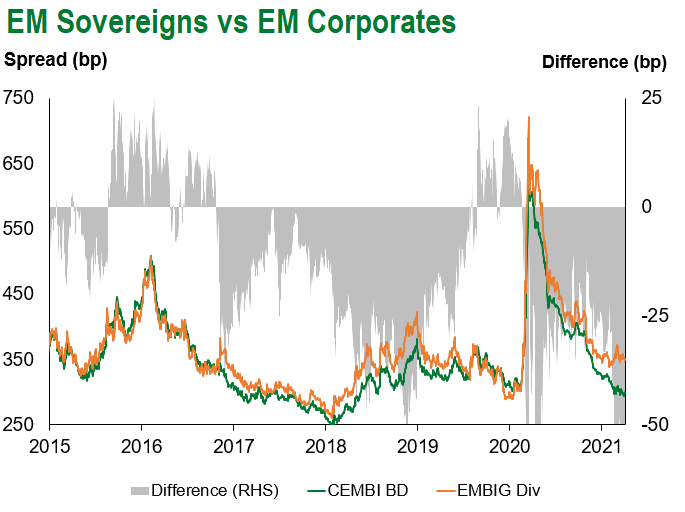
Emerging Markets Flows
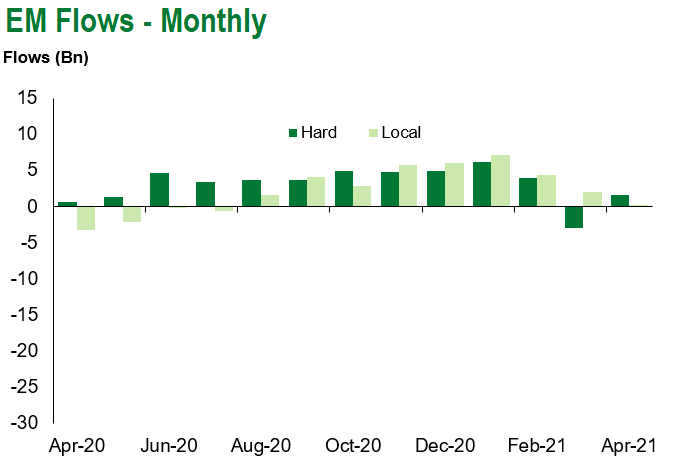
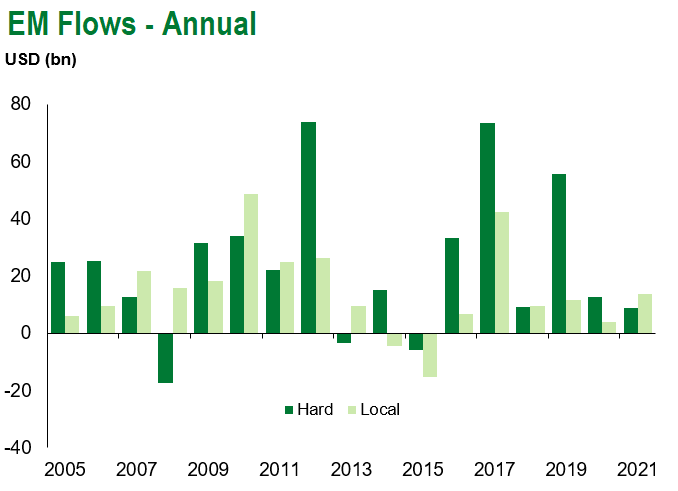
Source for graphs: Bloomberg, JPMorgan, Gramercy. As of April 9, 2021.
COVID Resources
Emerging Markets COVID-19 Case Summary
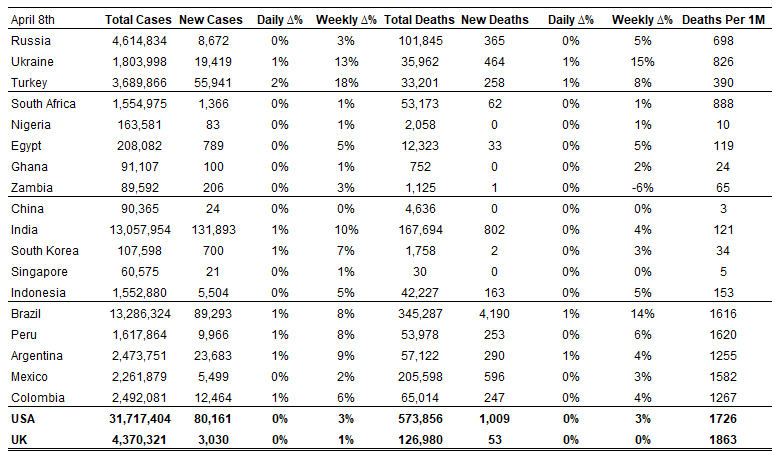
Source: Worldometer as of April 9, 2021.
Additional Crisis Resources:
Johns Hopkins COVID-19 Case Tracker
For questions, please contact:
Kathryn Exum, Senior Vice President, Sovereign Research Analyst, [email protected]
Petar Atanasov, Senior Vice President, Sovereign Research Analyst, [email protected]
Tolu Alamutu, CFA, Senior Vice President, Corporate Research Analyst, [email protected]
James Barry, Vice President, Corporate Research Analyst, [email protected]
This document is for informational purposes only. The information presented is not intended to be relied upon as a forecast, research or investment advice, and is not a recommendation, offer or solicitation to buy or sell any securities or to adopt any investment strategy. Gramercy may have current investment positions in the securities or sovereigns mentioned above. The information and opinions contained in this paper are as of the date of initial publication, derived from proprietary and nonproprietary sources deemed by Gramercy to be reliable, are not necessarily all-inclusive and are not guaranteed as to accuracy. This paper may contain “forward-looking” information that is not purely historical in nature. Such information may include, among other things, projections and forecasts. There is no guarantee that any forecasts made will come to pass. Reliance upon information in this paper is at the sole discretion of the reader. You should not rely on this presentation as the basis upon which to make an investment decision. Investment involves risk. There can be no assurance that investment objectives will be achieved. Investors must be prepared to bear the risk of a total loss of their investment. These risks are often heightened for investments in emerging/developing markets or smaller capital markets. International investing involves risks, including risks related to foreign currency, limited liquidity, less government regulation, and the possibility of substantial volatility due to adverse political, economic or other developments. The information provided herein is neither tax nor legal advice. Investors should speak to their tax professional for specific information regarding their tax situation.